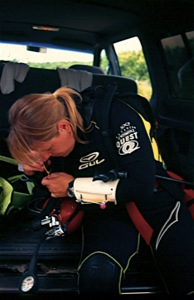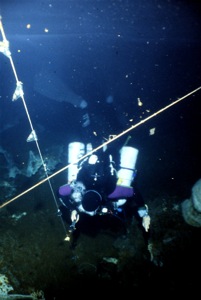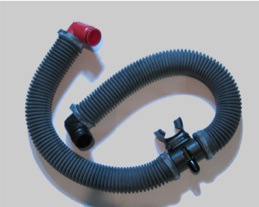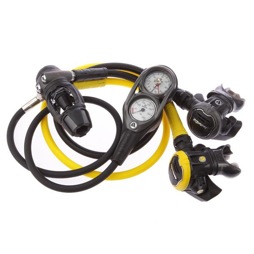
TECH CORNER:
What I have done over the many years that I have been diving is come up with ideas on how to make my dives safer and easier. Some of these ideas could save a life for example, the fin emergency safety strap (FESS), something that I came up with following the death of a friend. It is sometime difficult to imagine that a life could be snuffed out as a result of an item that broke that only cost about $2.00. Oddly enough, it happens a lot and yet as the dive industry continues to come up with more wild colours and useless designs for general purpose dive gear, the most simply of safety features fall by the way side. Until you have nearly died or a close friend has died as a result of a design failure, most people do not give it much thought and in turn, it is not considered a marketable product. So the creation of the Tech Corner following a few cold stubbies; helps lubricate new ideas out into the open. I hope that you might find some of these ideas helpful. Safe diving but most importantly, keep your snorkel open :>)
It’s hard to believe that a little thing like a fin strap can be a killer, but every year divers are injured or worse when these small-ticket items break.
Resort operators all have their tales of divers rocketing to the surface in a panic over broken fins straps, often resulting in a trip to the nearest recompression chamber. Cave and wreck divers face the opposite problem: trying to propel themselves out of an overhead environment after losing their means of propulsion. The first instinct is to kick like crazy, elevating consumption of precious air supplies. Such exertion is doubly threatening to deep-diving explorers who could black out from the resultant rise in CO2. And certainly a team member’s ability to help his or her buddies is compromised when a diver loses a fin. One afternoon after the August 1997 loss of a diving colleague, Rob Parker, I looked at my fins and wondered if the outcome of that dive would have been different had Rob’s buddy not lost his fins while trying to assist him at 250 feet/76 metres depth in a blue hole in the Bahamas. That drove home the seriousness of losing fins and inspired the fin emergency safety strap.
Cave divers carry redundancy to the extreme bringing three lights, spare masks, extra air - but almost never spare fins, because they are so cumbersome. So why not just carry extra straps? They’re tough enough to change while sitting comfortably at a table with good lighting. Try changing one in a low cave passage with current and lots of organic material to stir up; it’s just not practical. Nor are the innovations announced with fanfare every year by manufacturers. They make fins in bright colours; they tout the efficiency offered by design improvements. But none has yet introduced a backup system to keep fins from being lost. Adding this homemade safety strap will cost a little time and about $15 US , but, to paraphrase a well-known hair coluring ad, “You’re worth it.”





(1) Drill two holes in the fin
near the top of both sides of the foot pocket. In one hole attach a piece of cord long enough to allow full extension of the foot with the fin on. Then, either splice a snap shackle onto the cord or secure it with tie wraps. In the other hole, affix a piece of bungie cord by feeding both ends of the cord through the hole in the boot and secure the ends back onto itself with tie wraps.
(2) Install a small ring on the inside side of each bootie. Clip the bungie cord from the fin onto the ring, then adjust the cord’s length so it is taut when the foot is extended with toes pointed in a fin-kicking position. This attachment alone will be enough to keep a fin on a foot while traveling a short distance.
(3) For longer distances, detach the snap
shackle from the ring on the bootie, pull
it around your heel and attach it to the
bungie cord. This should feel as snug as
if you had the original fin strap in place.
This arrangement will keep a fin on while
traveling an extended distance to safety.
Other Ideas
For you overhead diver who use silver cloth tape or duct tape to secure your fin straps so that they do not hook on the guide line; there is a better and less sticky way of dealing with that problem. Find an old wetsuit top that you are no longer going to use and measure about 10 cm (4 inches) from the elbow, up the arm and below the elbow so that you end up with a 20 cm (8 inches) of the middle of the arm of the suit. It is important that you get the bend of the arm in the section; and cut out that section. That’s all you have to do. Each time you suit up, before you put your bootie or put your fins on, pull these ankle socks on, than the bootie and than the fin. Once the fin is on, pull the ankle sock over your heal and down to the point that you cover your straps. This is a great system to use in combination with the FESS strap. You will never have to deal with sticky residue or hooking problems again.

One thing that many folks don’t know is that the hoses of many of the rebreathers in use today can after a period of time become health hazards. Condensation, and other things that I won’t mention here accumulate and become bacterial feeding grounds. Not cleaning these hoses and other dive equipment that is inserted into the mouth can result in chronic sore throats and other upper respiratory issues. Earlier, the solution of choice was iodine and water in which the hoses could be soaked. However, there now is a better solution. The O2 rinse discussed in the, ‘In field first aid,’ section of this website is ever better. This solution is equivalent to cold sterilization. It is used in surgical suites to sterilize the counters and other equipment that can not be shoved into a steam sterilizer. Pouring some of the solution into the hose and shaking it back in forth for a few seconds is enough. Rinsing is not necessary. This is the ideal solution for dive shop owners that feel the need to clean some of their rental equipment.


Hose Management on Sidemount Set: Simple and clean...and cheap!
Apeks, whose regulars I use and have used for years because they just perform so well in all my crazy environments have now, certainly after much wishing on my part, generated a commercial regulator set for sidemount configuration. Whilst many have been using this set up, for those who are still absorbing the joys of using such a configuration, I have provided some ideas for securing hoses on your tank. One issues that we face, certainly in the cave environment is that we cannot secure regulators to the point that in a tight spot, it might take a few minutes to unclip a regulator so that it can be used. A cave environment, especially in the Bahamas doesn’t offer a few minutes of time in many cases. So as a result, we have designed a quick release system for regulator hoses that works really well, certainly for me. What is also nice is that when I am finished with the regulator, I can very easily secure the hose back onto the tank without missing a fin stroke.

Above we generated a ring using a 1 cm thick bungee cord that we secure with tie-wraps. Before securing with tie-wraps we thread in two large plastic beads that can be purchased from a marine supply store. They are about $2 each. Why the beads? It makes it easy to grab without having to look for or feel for the bungee cord. The beads are large and distinct enough to know that when you feel them, you know exactly what they are. The regulator hose can be looped and then secured under the cords with the regulator head at the top, naturally. Enlargement photo below.

For those interested in the hardware that we use at the top of the bottle to secure the BC, its just a brass ring. Those are just a couple of dollars at your local dive shop or marine store. The rings on the bottom of the tanks are very large hose clamps with a similar brass ring at the bottom to secure the bottom of your BC. What is particularly nice about this set up is that you can rig up your bottles, set them where you are going to get into the water, get your kit on, including fins, sit down between these bottles and just clip them on and go. The same in reverse when you get out of the water. For in water exits, I just unclip the bottles and clip it onto a down line and get out of the water with my BC on. In rough seas where I have played, catch the stern, this is sometimes not a bad thing. Especially if you get yourself knocked out, the BC should keep you afloat until you receive help. Bad stuff happens to the best of us.
